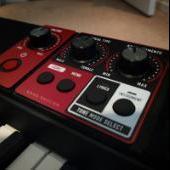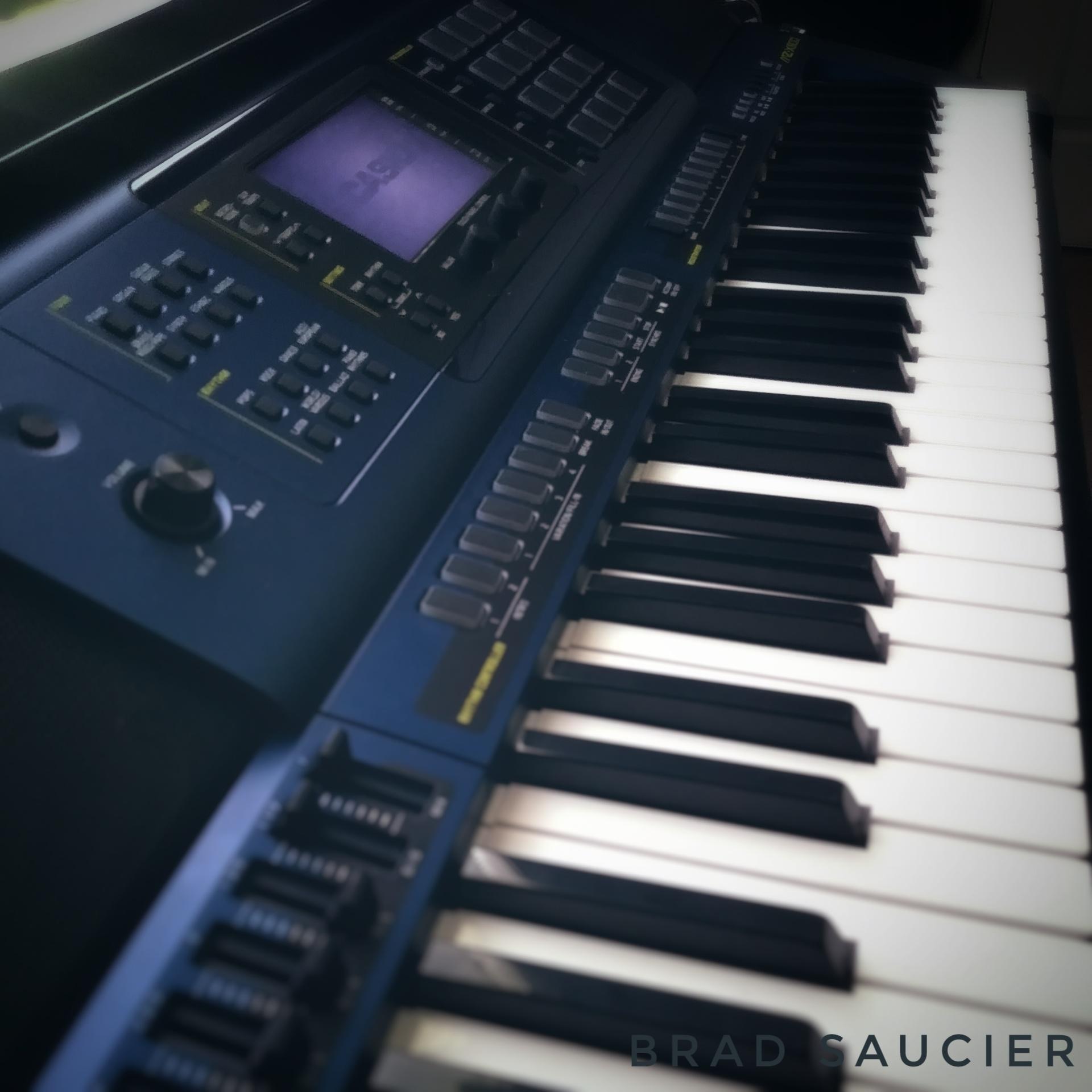-
Posts
8,742 -
Joined
-
Last visited
Content Type
Profiles
Forums
Downloads
Everything posted by Brad Saucier
-

Problems with the quality of recording.
Brad Saucier replied to Gnomo Alegre's topic in General XW Series Discussion
David, I ran your sample through a spectrum analyzer. I'm fairly certain that Audacity is the cause of the sound that your not happy with. The recording has no audio data over 8,000 Hz. Here's why. Audacity's default "Record" sample rate is set to one of the lower rates. My guess is it's set to 16,000Hz. That prevents Audacity from recording the higher frequencies of sound. Change the default to 44,100 Hz. This will allow Audacity to record the full range of sound. The equipment you suggest: I would add a mixer only if I needed to record more inputs at one time or needed a quality microphone preamp. I wouldn't buy the U-control. The Realtek Soundcard already performs the analog to digital conversion well enough for a starter studio. -

Problems with the quality of recording.
Brad Saucier replied to Gnomo Alegre's topic in General XW Series Discussion
I don't think you need a new sound card for what your doing. I have used the Realtek High Definition Audio sound card. It sounds great. I suspect your sample rate was set very low. Make sure Audacity is set for 44.1hz. Menu>Edit>preferences>quality>default sample rate>44000hz -

WK-7500 no usb midi output form keys or pedal
Brad Saucier replied to Bossbandbob's topic in WK-7500/7600 - CTK-7000/7200
I'm glad to hear Mike is helping you get your WK serviced. I guess our job here is done. -
I'd try this first. This is the latest driver for Windows. It should work for you. From the Casio Support Page: • Supported operating systems: Windows Vista® (32-bit)/®7(32-bit)/®8(32-bit) Driver Download: CCMID12_INST.zip(272KB) Here's the entire page: http://support.casio.com/download.php?cid=008&pid=340&rgn=1
-

WK-7500 no usb midi output form keys or pedal
Brad Saucier replied to Bossbandbob's topic in WK-7500/7600 - CTK-7000/7200
Yes, Yamaha pedals are reverse from Casio pedals. It's normal. If you use the Yamaha pedal on the Casio, "no sustain" would be achieved by depressing the pedal and "sustain" by letting go. The PX-5S auto detects the polarity of the pedal when you power on the unit. If you have a Yamaha pedal plugged in while you power on and then change out to a Casio pedal without rebooting it the operation will be reverse. I don't think the WK-7500 does this. -

Ideas for Casio's Next Synth Platform
Brad Saucier replied to AlenK's topic in General Casio Discussion
I was so busy explaining that only one insert DSP effect for a channel is possible that I neglected to mention that each of the 4 zones can have its' own insert. Sorry Alen. Bad me. -

Very interested in the PX-5S, just need some info
Brad Saucier replied to Jefsong's topic in Privia Pro PX-5S
-
Hi guys, I did some research. The PX-320 is much older than the WK-7500 and was made before Casio changed to the class compliant system. It requires a driver and unfortunately no Casio driver supports Apple products. The PX-320 was originally bundled with a CD that contained a driver. That driver only supported these OS: Windows® 98 / 98SE / Me / 2000 Professional / XP Home Edition / XP Professional. For more info check this page.. http://www.casio-intl.com/asia-mea/en/emi/past/privia/px320.html What OS is running on your Lenovo? There are newer drivers available for newer versions of Windows here. http://support.casio.com/download.php?cid=008&pid=340&rgn=1
-
Guys, I'm just guessing about the firmware update. I only know what I read in the forums. I would not get my hopes up for any kind of firmware update. My guess is that they might, but that's just my guess. As far as the timing issue. It does not happen all of the time. The factory demo song plays great. I've recorded phrases myself that stay synced for as long as I've listened to them. And then others don't. ??? Would I like to see a firmware update? Do I want to see some user suggestions make it into the update? Of course. We all do. But don't hold your breath. At some point Casio will draw the line and end all development on this product. Any updates would only be for correcting faults.
-
Just a heads up for you Luis... If you do use the song sequencer. There's something weird with the phrase timing in the PX-5S. The phrases will get out of sync after some time. From what I know, Casio is investigating the issue. My guess is it's just a firmware issue and will be corrected with an update.
-

WK-7500 no usb midi output form keys or pedal
Brad Saucier replied to Bossbandbob's topic in WK-7500/7600 - CTK-7000/7200
Sorry friend. Keep us informed. -
1,152 downloads
This Version of the Piano has Key Noises added. Release and Attack sounds are on a hex layer in Zone 2. Slider 2 adjust the level of attack key noise which adds more low end to the attack that is contained in the original piano sample. The added noise is more apparent in the upper octaves. Slider 3 adjust the level of release key noise. Adjust to taste. The default levels were set using headphones. You'll need to adjust the levels depending on your listening environment and style of playing. Start by quickly adjusting the slider levels to the extremes while playing a few notes to get an idea of the sound your adding to the mix. Turn off Zone 1 to hear the key noise alone. This Piano still includes Early Reflection DSP and the adjustable wet level for it is on Slider 5. Adjust to taste. The stock PX5 piano is dry. If you like a wetter sound then you should try this. BTW. With Sliders 2, 3 and 5 all the way down this Piano becomes similar to the stock piano. You can get a lot of variation in the piano sound by just playing with all of the sliders and knobs on this stage setting. -
909 downloads
This is a stage setting along with the appropriate phrase for playing Piano to a metronome. The desired time signature is defined by the phrase you choose to play. Download and place the desired phrases in empty user slots. Press the phrase button and choose the one you want using the + - buttons. "Metronome" phrase is 4/4 time Others are....5/4, 6/8, 3/4 and 2/4. -
It's not simple. You have to create a stage setting with the piano you like on zone 2 and drums on zone 1. Create the phrase you want and save it. Set the arpeggiator to target the phrase you want. Turn on the arp for zone 1 and off for zone 2. Set "org note" to "fix". Set the arp to "hold" and begin playing. You may have to adjust the zone levels to balance the sound. Save all of that as a new stage setting.
-
Your right, this cannot fully emulate a volume pedal. But for many instances it can be useful. Configuring the pedal is easy in the data editor. Select the Stage Setting Common tab. Scroll down to pedal 2 and select the target as volume. Set your volume min and max as well as the on off rate as desired and then choose momentary at the bottom. After that go to the Stage Setting Zone tab and scroll down to the controller section and make sure pedal 2 is enabled for the zone you want it to affect. If you don't want it to effect any other zones then disable those.
-
Yep, Thanks Mike.
- 14 replies
-

WK-7500 no usb midi output form keys or pedal
Brad Saucier replied to Bossbandbob's topic in WK-7500/7600 - CTK-7000/7200
I did have a DC power jack break loose from its solder joint to the PCB in my MZ-2000 just from normal use. Although when it did there was a noticeable wobble in the jack. So if your jack feels normal then it's probably not a physical issue. I'm guessing it's something real simple in a menu somewhere. It's just finding that. The initialize function should have cured any issues on the keyboard end of it. Are you running Windows on your ASUS netbook? Does the mouse pointer change when you unplug and re-plug the USB cable from the CASIO? For me, on the PX5, if I unplug the USB cable the mouse pointer shows the busy circle for an instant. This could be a clue for you. -

WK-7500 no usb midi output form keys or pedal
Brad Saucier replied to Bossbandbob's topic in WK-7500/7600 - CTK-7000/7200
Have you initialized all data in the WK-7500 yet? -
Hi Ralf. Casio has invented something new for the PX-5S. Check it out starting at 3:30. Mike's example is for a filter envelope but it can be changed to volume and the timing of the ramp up/down can be custom preset.
-

Ideas for Casio's Next Synth Platform
Brad Saucier replied to AlenK's topic in General Casio Discussion
I can only compare the MZ Distortion effect to the PX-5S. I have not heard the XW Distortion. I can say that the Distortion effects on the MZ-2000 have always been a favorite of mine. Thanks for the link.



